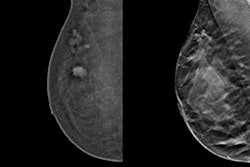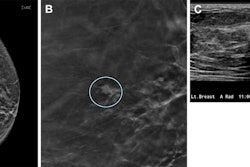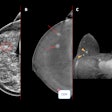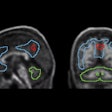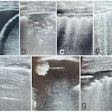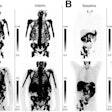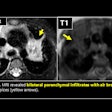Both patients and imaging professionals are finding digital breast tomosynthesis (DBT) to be a more acceptable breast cancer screening method than digital mammography (DM), according to a recent Dutch survey.
The group, led by Lindy Kregting, PhD, a postdoctoral researcher at Radboud University Medical Center in Nijmegen, ran a prospective, nonrandomized trial involving women in the Dutch breast cancer screening program. Named the Screening Tomosynthesis trial with advanced REAding Methods (STREAM), the study’s aim was to determine the impact, outcomes, and cost-effectiveness of using DBT screening, while optimizing reading.
DBT has been shown consistently in numerous studies to have both greater accuracy and lower recall rates than DM, but before implementing DBT in screening programs, it is essential to determine its acceptance among both patients and the screening radiographers and radiologists who use it, Kregting and colleagues noted in a poster presentation at ECR 2025.
Therefore, the team “aimed to investigate the acceptability of DBT screening among screening participants and professionals within the STREAM trial compared to DM screening.”
Of the 44,682 participants invited from the screening program, 18,225 participated in the first round of the STREAM trial. Approximately 100 screening radiographers and 35 screening radiologists took part. Participants were asked to complete an online survey about the acceptability of DBT screening.
For patients, questions were asked about pain, discomfort, and anxiety using a four-point Likert scale and a pain scale from 0 to 10. They were also asked about their intention to participate in DBT screening in the future. For comparison, a reference group of screening participants who had undergone DM screening was asked to complete the same questions on pain, discomfort, and anxiety for comparison, using the same scoring.
Radiographers and radiologists were asked questions about the ease of use of DBT screening. All participants were asked to provide suggestions for improvement for the screening process.
The survey was completed by 10,983 of the 18,225 screening participants (60%). Of the respondents, 39% reported DBT as being not painful at all (compared with 27% for DM); 52% reported it as producing only some pain (46% for DM). No or some discomfort was reported by 93% (compared with 76% for DM); 97% reported having no anxiety at all, compared with 88% for DM.
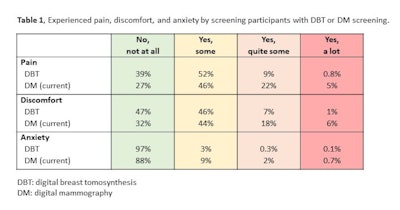 Courtesy of Kregting et al and presented at ECR 2025.
Courtesy of Kregting et al and presented at ECR 2025.
Pain scores were lower for DBT than for DM: the average pain score given was 3, which was lower compared to both the average score for the reference group (4.3) and the average score that participants had reported for their previous DM (3.5). Moreover, 13% of the DBT participants scored their pain at 0, compared with 9% for both the current DM reference group and previously reported DM scores. Severe pain (a score given between 7 and 10) was reported by 13% for DBT, 17% for previous DMs, and 29% for the current DM reference group.
While 52% preferred DBT over DM and 46% had no preference -- a finding the authors mainly attributed to these participants having experienced no difference between the two modalities -- 98% said that they would participate again in future DBT screening.
The radiographers who responded were generally satisfied in working with DBT, but the radiologists requested more improvements, primarily in loading and reading times.
Kregting and colleagues pointed out that the feedback they received from this survey is being used to improve the second round of DBT screening in the STREAM trial.
Read the full ECR 2025 poster here. Also, for more details on the trial, go to "The Screening Tomosynthesis Trial with Advanced Reader Methods (STREAM): design and rationale of a population-based breast cancer screening trial," 9 January 2025, European Radiology, here.





